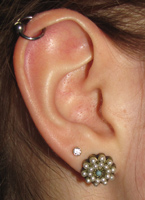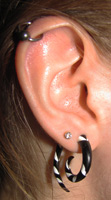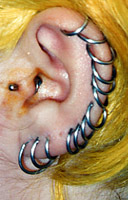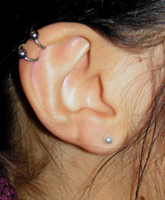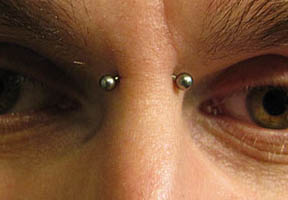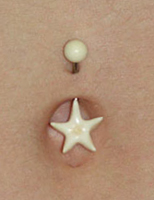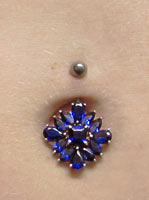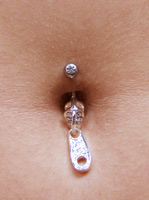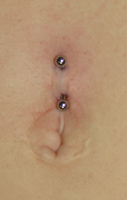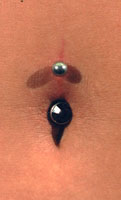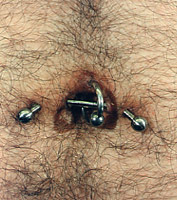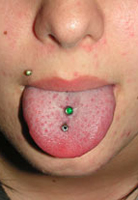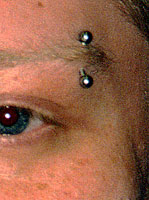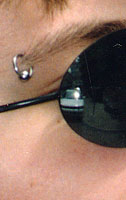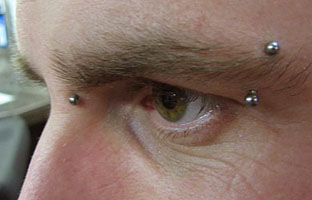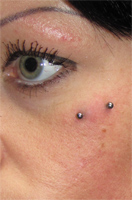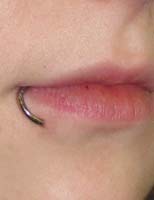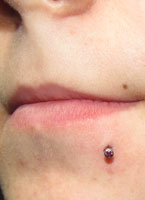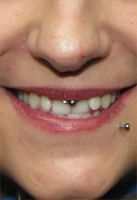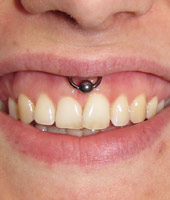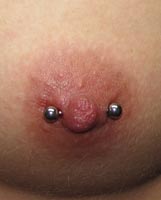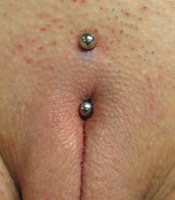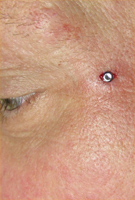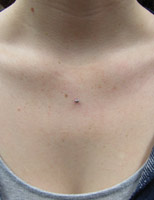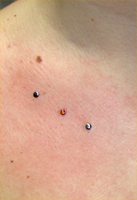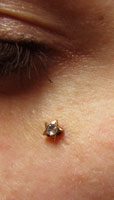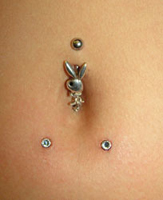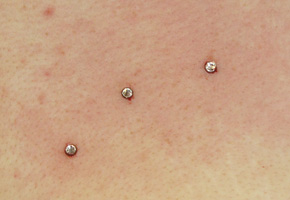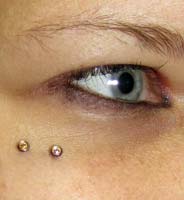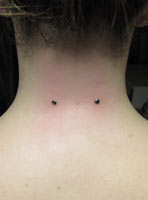Tattoos
I'm only interested in huge projects without artistic boundaries, because it is the only possibility to fit art to the human body. I of course am able to orient on a given topic, abstraction or keyword. People, who prefer little tattoos, will be served by my employees, who are used to the trendy little tattoos.
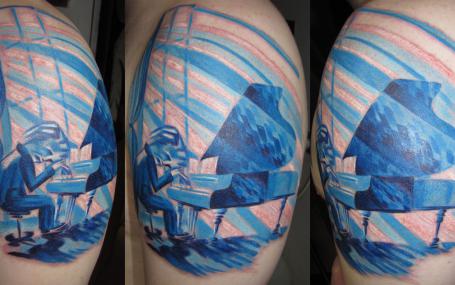
Courses
Talent is not all for a tattoo artist. It is not the most important skill to just be able to draw. You have to obtain an enormous amount of knowledge. Just the skin as a medium on its own is a specific and huge topic. Followed by technical topics, knowledge about the machine and how to use it. Further important topics are dermatology, Hygiene, virology, bacteriology and even more.
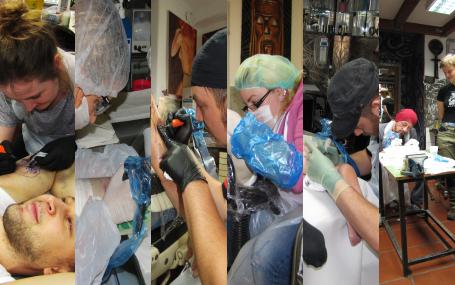
Course details
Most of the educational institutes, which provide an education to become a tattooist, host courses with a huge amount of participants. So there is no room to handle every student individually. This tattoo course has the big advantage to be hosted in little groups. The severity of practices and the provided learning material are adjusted to each member of the course. An important requirement for the tattoo course is the ability to draw. For this reason you have to come by personally and drop off your art map. The course is build on the base of three sections. In the first section you learn the medical knowledge you need to know. In the second section you will learn how to prepare your working space and management of a tattoo studio as directed. In the third section you will have to prepare a complex tattoo on your own. There you will learn advanced techniques when using professional machines, color theory and anything else you need for the true artistic tattooing. In the end of the course you will be able to tattoo under supervision of an qualified person. The course is based on the current federal law. It will be documented and the participants will become a certificate, which proofs a positive graduation of the tattoo course. It is the right and fastest way to become an position or to word independently. You will become for every course an invoic. The paid expenses cover provided material during course time.
Here you will find detailed information for each course section
- Medical basics of tattooing
- Dermatology
- Anatomy
- Somatology
- Hygiene and infection doctrine (virology, bacteriology, mycology, vaccination, sterilisation)
- Allergies and other contraindications
- Contagion avoidance
- First Aid
- Self protection actions to be taken
- Psychology (general knowledge of human nature, assessment of young customers)
- Duration
- 33 hours
- Times
- Tue – Sa before midday
- Expenses
- 1 530,- €
- Legal basics and requirements (on base of Federal Law Gazette)
- Studio facility and planing
- Care of machines
- Preparation of instruments and working space
- Hygiene and protective behaviour during tattooing
- After tattooing process (Cleaning and disinfection, sterilisation, disposable)
- Every days hygiene of tattooist, facilities and instruments
- Professional customer advice
- Customer clarification (instruction about after care)
- Documentation about customer and work process (sterilisation protocol, cleaning plan, informed consent of customer, intervention documentation aso.)
- Template drawing and preparation
- Tattooing on skin replacement
- Duration
- 33 hours
- Times
- Tue – Sa before midday
- Expenses
- 1 530,- €
- Color theory
- Right working machines as the way to perfection
- Differences between tattoo colors
- How to braze on needles on your own
- How to draft complex tattoo motives
- Sketch out directly on the skin
- Drawing practices to perfecting tattoo motive
- Artistic studies about contoured drawing (proportion and perspective)
- Successful cover ups
- Written final thesis
- Tattoo under supervision of an qualified person
- Duration
- 31 hours
- Times
- Tue – Sa before midday
- Expenses
- 1 438,- €
Under certain circumstances it is possible to get the tattoo course refunded by AMS or other institutes as the IP Center. It is worth asking!
You find important informations from WKO here (only in German!):
Befähigungsprüfung Kosmetik (Schönheitspflege) eingeschränkt auf TätowierenTattoo preparation courses
Preparationcourses for Austria's written tattoo artist exam
The only requirement to participate at the qualifying examination is to be at least 18 years old. This exam consists of three modules: a practical, an oral and a written exam. New questions were written lately and were taken under consideration in this course. The written module consists of 300 questions out of different topics and have to be answered in a short period of time. This course helps the participant to answer this questions quickly and correctly. The participant also gets a lot of hints to have a more reliable chance to past the exam.
- Audience
- Everyone, who wants to prepare for the qualifying examination to become a tattooist.
- Duration
- 1 day (about 6-7 hours)
- Expenses
250,- €
Drawing preparation course for Austria's tattoo artist exam
In the written proficiency examination, among other things, a cover-up drawing is required. There and in general fast drawing is of advantage because you are under great time pressure. This course is designed to help the participant make an efficient and well-executed drawing during the written and practical exam. The participant receives many useful tips to complete the exam more reliably.
- Audience
- All those who want to prepare for the written and practical proficiency exam for tattoo artists.
- Duration
- 1 day (6-7 hours)
- Expenses
250,- €
Reduction for Shockin‘ City graduates: 225,- €
Tattoo Internship
As an extension of the tattoo course an additional tattoo internship is provided. A trainee is able to get in touch with every days work at a tattoo studio, practice customer pitches, everything about clean utility and instruments into detail. In addition the trainee works on creating a tattoo in the studio from the scratch under supervision of a competent person. The duration of the internship depends on the trainee and will be customized.
- Audience
- Everyone, who already finished the tattoo basic course and wants to collect additional experience
- Duration
- customized. You can start anytime
- Expenses
-
- 130,- € / day
- 550,- € / week
- Reduction for Shockin‘ City graduates
- 100,- € / day
- 500,- € / week
Opinions of course graduates
Meiner Meinung nach passen Medizin und Tätowieren wunderbar zusammen und den Kurs bei Osa zu machen, war für mich die absolut richtige Entscheidung, da ich mich schon lange einer neuen, kreativen Herausforderung stellen wollte. Ich würde jedem, der das Tätowieren professionell und verantwortungsvoll ausüben möchte, empfehlen seine Ausbildung bei ihr zu machen. Im Kurs herrscht eine entspannte, freundschaftliche Atmosphäre und sie unterstützt ihre Schützlinge bestmöglich. Einerseits bekommt man vermittelt, wie viel Verantwortung man als TätowierIn für seine Kunden hat und wie viel Übung es braucht, um gut zu werden, aber gleichzeitig verliert man dank der Unterstützung auch nie den Mut und den Spaß am Tätowieren. Auch wenn ich wahrscheinlich diesen Beruf nie vollzeitbeschäftigt ausüben werde: die Erfahrung, auf echter Haut zu arbeiten, ist alle Mühen wert und werde ich nie vergessen!
- Analena
Was mich so sehr beeindruckt hat beim Kurs, ist die bemerkenswerte Individualität, die Osa an den Tag legt. Sie hat einen wahnsinnig inspirierenden Funken in sich .. anfangs blinzelt er nur, im Lauf des Kurses erkennt man ihn immer mehr und wenn man sie dann mal tätowieren sieht, zeigt er sich mit voller Wucht und man kann nicht mehr aus. Genau so ist auch der Kurs. Anfangs etwas träge, da viel viel Theorie durchgenommen werden muss. Das wird aber mit Leichtigkeit geschafft, da Osa ein sehr kompetentes Fachwissen hat und das auch gut an den Mann bringen kann. Weiter geht's und man nähert sich der Praxis mit kleinen Schritten, es wird spannender, interessanter, gleichzeitig finden alle Beteiligten immer mehr Spaß an der Sache, bis es schlussendlich zum Highlight kommt: dem Tätowieren .. Immer wachsam, immer ein Auge auf den Schüler und auf das was er tut, Tipps, Ratschläge und Problemlösungen anbietend, ist man hier wirklich in sehr guten Händen. Jeder, der Wert auf eine kompetente, sympathische, individuelle Ausbildung zum Tätowierer machen will, dem kann ich den Kurs bei Osa nur ans Herz legen.
- Lollo
Piercings
That‘s how we work
"First comes hygiene! All surfaces are cleaned with a corresponding disinfectant and the instruments are taken out of a sterile packing. I only use disposable needles and sterile gloves.
Next step is to disinfect the skin, the most fitting place on the skin will be selected and marked.
Only after all those preparations I will pierce you and the selected piercing jewellery will be put in place."
Lobe
Lobe piercing is the most common piercing as lobe stretchings. The first piercing jewellery should be a ring or a stud. If a stretching is wished later, the lobe should not be pierced too low. Variations are transverse (not from the front to the back, but from left to right) and vertical (up to down) lobes. Healing time: 2-3 weeks
Helix
A piercing through the cartilage on the top side of the outer ear. Frequently several helix are pierced one to another. As first jewellery it is recommended to use studs and rings. Healing time: 4-6 weeks
Industrial
Two opposite helix are connected with a long stud. Healing time: 1-3 months
Tragus
It is a piercing through a little cartilage of the auditory canal. Tragus is also vertically available. In dependence of the form a ring or a stud should be used. It the tragus is too little it is not adviceable to pierce it. Healing time: 4-6 Wochen
Rook, Daith, Snug, Conch, Anti-Tragus
Piercings which are pierced through certain cartilage lines. Depending on the place the healing duration lies between 1 - 4 months.
UFO
Rook and Helix are connected with a ring. As a variation the Rook, Helix and Anti-Helix can be connected. 2 - 3 Plugs can be used as compensatory jewellery and after it’s healed swaped with a ring. Healing time: 3 - 4 months.
Nostril
That's the way the Nasal Wing Piercing is called. This is often shot to save costs, with the ear piercing gun, but this is not recommended, because the jewelry used for it is qualitatively rather inferior, the closure is disturbing in the nose and the sharp tip of the plug is supported by the middle nasal wall and often causes pain there. The suitable jewelry is either a piercing ring, a spiral plug or even better a plug with a ball closure, much like a lip piercing. Healing time: 2-3 weeks
Bridge
Piercing through the skin fold above the nasal bone, between the eyes. It is best to use a bent plug to minimize the risk of outgrowth. When placing one should pay attention that the field of view is not limited. Rarely the bridge is also available in vertical variation. Healing time: 4-6 weeks.
Septum
This is a piercing through the nasal septum. As with all parts of the body, the septum is a bit different for each person. Depending on the severity, you can either sting through the thinner areas above or below the cartilage. In people with a very oblique nasal septum, this piercing is not recommended, as it would not look symmetrical. As a jewelry rings or plugs can be used. If you have stretched a septum piercing, there is the possibility to get a so-called Septril. Here a Labret plug is inserted so that the ball on the lower nose side in the middle is visible. Healing time: 2-4 weeks.
Austin Bar and Nasallang
Very rare nose piercings. An Austin Bar runs horizontally through the cartilage at the tip of the nose. A nasal lunge goes through both nostrils and the nasal septum. As jewelry plugs are used. Healing time: 2-3 months.
Tongue Piercing
The usual variation of the tongue piercing extends vertically through the axis of symmetry of the tongue. This piercing is relatively easy to care for and there are rarely complications. As a first use you use a slightly overlong plug to leave a possible swelling space. After healing, you can change the jewelry to a shorter plug. For care you should do without aggressive disinfectants, rather chamomile or sage tea rinses are recommended here. During the care you should not consume dairy products. Healing time: 10-14 days.
Venom
That's how two tongue piercings placed vertically next to each other are called. As jewelry plugs are used. Since in this case the jewelry is stung through the tongue muscles, it can lead to complications in the form of speech disorders and food intake problems.
Lingual Frenulum
A horizontal piercing through the cuticle below the tongue. In this area you can use small rings or plugs. The cure is usually fast and easy. If the strap is too small, it is not recommended to pierce, because it can lead to the outgrowth of the jewelry. Healing time: 10-14 days.
Surface Piercing
When getting a horizontal tongue piercing it is recommended to use a flexible PTFE plug as a jewelry, so that the tongue is disturbed as little as possible in it's mobility. The healing of these piercings is very tedious in contrast to a vertical tongue piercing.
Eyebrow Piercing
The eyebrow piercing is usually made vertically on the outer third of the eyebrow, but there is the possibility to pierce the piercing at different angles or horizontally. Since it is actually a surface piercing, the outgrowth occurs here more often. But if you notice it early enough, you can counteract this process by using suitable jewelry. When healing you should make sure that no cosmetics enter the branch canal. Healing time: 2-4 weeks.
This is how surface piercings around the eye are called.
This is how surface piercings around the eye are called.
Chin
A labret piercing is placed in the middle of the lower lip. Possible jewelry here is a Labret plug or a ring, a plug is placed further down so that the gums are spared, the ring is not too far below the lip red, so that the lip is not pressed by the jewelry. As with most Labret piercings irritation to the gums can be caused. A way out is the flexible PTFE Labret plug. The first use jewelry should allow a little more room for the swelling of the lip after piercing, so the first plug must be a bit longer. After healing, you can use a tight-fitting jewelry. Healing time: 4-8 weeks.
Madonna
Thus, a Labret piercing laterally engraved on the upper lip is called. The jewelry used is a Labret plug, usually with the smallest possible ball.
Medusa
A piercing in the middle of the upper lip, through the vertical groove between the upper lip and nose. As jewelery a Labret plug is used.
Vertical Labret Piercing
The lip piercings are also feasible in their vertical variations, being stung by the lip red. The advantage of a vertical labret piercing is that it does not come into contact with the teeth and gums. Healing time: 4-8 weeks.
Labial Frenulum Piercing
Comes to see only when the upper lip is raised when smiling, so it is often referred to as "smiley". Since it is stung only by a thin mucous membrane, healing is very quick and unproblematic. Because of a too small labial frenulum shape, this piercing can not always be stung. As jewelry here are either small rings or short plugs of 1.2 to 1.6 mm in diameter. Healing time: 1-3 weeks.
Cheek Piercing
The cheek piercing is stung at the point of the cheek pits. Since there are important nerves and larger blood vessels in this area, caution should be exercised while piercing. As jewelry a Labret plug is used, which should be at the beginning clearly longer, in order to give place to the swelling. The healing is about 2 months. A recommended alternative to the Cheek Piercing is the Cheek Microdermal (Dermal Anchor). An implant at this point causes much less problems than a piercing: the important facial nerves and arteries remain unaffected; the teeth and gums are not irritated because the jewelry on the inside does not stick out; the healing is easier. For these reasons, one should consider whether a Cheek microdermal would be more desirable.
Nipple Piercing
The nipple piercing is pierced either through the nipple or through the nipple vestibule. Mostly it is horizontal or vertical, but any angles are possible. You can also make several piercings on top of each other. The healing and nursing time are here, as with the navel, of longer duration. As jewelry you can use different rings or plugs, with a minimum thickness of 1.6 mm is recommended, otherwise it can come out to grow. Any decorative jewelry should be used only after complete healing, so as not to disturb the care. Healing time: 3-6 months.
Inner Labia
An uncomplicated and fast healing piercing. Here, a wide range of jewelry can be used, even strains are possible and easy to carry out. The minimum thickness for jewelry should be 1.6 mm, otherwise the fabric can be torn. The piercing has more of a decorative purpose, but can also be stimulating by appropriate jewelry. Healing time: 2-4 weeks.
Outer Labia
For this piercing usually different rings are used. The stimulation is stronger here than in the inner labia. Healing time: 2-4 months.
Clitoral Hood
An uncomplicated, fast-healing and stimulating piercing. Can be stung horizontally or vertically. Accordingly, usually rings or connectors are used. A variation is the Diana piercing. These are two piercings pierced vertically to the left and right of the clitoris. For stinging enough tissue must be present, otherwise there is the danger of growing out. Healing time: 4-6 weeks.
Clitoral
The requirement for this piercing is a sufficiently large clitoris. It should not be less than 6 mm in diameter and should not be covered by the clitoral hood. The piercing is very painful and risky due to many nerve endings. As jewelry, rings are used for horizontal or plug for vertical variant. Healing time: 4-6 weeks.
Christina (Mons Veneris)
This is a surface piercing, which is stung vertically into the fold of the above converging labia majora. If the fold is not sufficiently pronounced, it should not be pierced because of the growth. This piercing does not stimulate and has only an optical appeal. Healing time: 3-4 months.
Triangle
This piercing runs horizontally below the clitoris through the clitoris hood and can stimulate the clitoris from behind. For stitching enough tissue must be present so that the jewelry has enough space. For more pronounced labia minora this piercing can be uncomfortable. Healing time: 6-8 weeks
Isabella
A vertical piercing that is inserted above the urethra and exits on the clitoral hood. Isabell piercing stimulates the clitoris from behind. As a jewelry a barbell is suitable. Since this piercing punctures the clitoris and important nerves can be damaged, it is considered particularly risky, so here are the alternative piercing advisable, eg. Nefertiti or Triangle. Healing time: 2-3 months.
Nefertiti
A piercing through the clitoral hood and the pubic mound. As first jewelry a length-adapted PTFE plug is used, later it can be exchanged for a barbell. The piercing is relatively safe, because it can not hit any major nerves and the risk of growing out is minimal, but the healing takes longer due to the long puncture channel than most intimate piercings and requires reliable care. Healing time: 3-6 months.
Princess-Albertina
A vertical intimal piercing that runs from the urethra opening to the vaginal opening. Mostly a ring with at least 1.6 mm thickness is used here. A rather rare piercing, as urinary tract infections often can occur there. Healing time: 2-3 weeks.
Fourchette
It is pricked vertically at the bottom of the clash of labia minora. Can not always be done due to anatomical reasons. Because of the short stitch canal, this piercing often tends to grow out. During healing, due to the proximity to the anus, a high level of hygiene should be ensured. Healing time: 4-6 weeks.
Suitcase
A piercing between the rectum and vagina. Due to the placement, this piercing often leads to infections. Healing time: 6-12 months.
Prinz-Albert
The puncture channel runs between the urethra and the lower glans margin. Mostly a ring is used here, whereby larger strengths of the jewelry (3-4 mm) are recommended, in order to avoid the tearing and to increase the wearing comfort. The cure is usually fast and uncomplicated. Healing time: 4-6 weeks.
Frenulum
The piercing goes through the thin soft cuticle below the glans. Use rings or plugs that should not be thinner than 1.6 mm. Frenulum heals quickly and unproblematically, the stinging is only slightly painful. Healing time: 3-4 weeks.
Ampallang
It's a pretty painful and long-healing piercing that runs horizontally through the glans. As jewelry you can only use long enough plug here. Healing time: 6-8 months.
Apadravya
Similar to the Ampallang, Apadravya is a difficult healing piercing. It runs vertically through the glans, but you can also sting it behind the glans. As approach of the branch canal the entrance of the prince Albert can be used. As jewelry here plugs are used. Healing time: 6-8 months.
Guiche
The stitch canal goes through the seam between the scrotum and the anus. As jewelry you usually use rings, after the healing, you can attach weights here. Healing time: 6-8 weeks.
Dyode
This piercing goes through the glans edge. It is performed excellently with circumcised men, because for the uncircumcised it is often disturbing and uncomfortable. Mostly you wear here pairs of plugs or rings. Healing time: 4-6 weeks.
Hafada
The puncture channel of the Hafada piercing runs through the skin fold between the scrotum and the penis base. This piercing is not particularly painful and has a decorative rather than a stimulating function. Most of the time you wear one or more rings, you can also attach weights. Healing time: 4-6 weeks.
Pubic
So that the healing time is shortened, this piercing should be stung just above the penis beginnings. As jewelry you can use rings or plugs. Healing time: 6-8 weeks.
Oetang
Here it is stung on the edge of the foreskin. Mostly you use two rings that you can connect to each other. There is also the possibility of using several rings or short plugs around the foreskin edge, however, never pierce more than two piercings at a time, as this area can swell considerably. Healing time: 3-5 weeks.
Stretching
Stretching is all about patience. Depending on the area of the body, you should only stretch 1 - 2 mm in one session. Caution and constant monitoring by the piercer are required for larger steps, so that there are no complications that can have devastating consequences, such as tears and scarring in the tissue, or even necroses, especially during stretching, so never experiment yourself, but let a skilled person do it!
Lobe
Stretching on the earlobe is one of the most commonly performed strains ever. Especially at the earlobe stretching is very feasible and you can often achieve amazing results of several centimeters of jewelry diameter. Begin the stretch with a properly applied earlobe piercing. After healing, you can start stretching.At each session it will be extended by 1-2 mm, although each time it has to be completely healed, otherwise the tissue will not be strong enough and may be much more likely to rupture. It is not recommended to pre-punch the praises, because at the beginning it accelerates the stretching, but the tissue that has been punched out is gone and a lot of tissue is advantageous at long expansions.Stretching on the earlobe is quite uncomplicated, provided, that the matter is handled properly and professionally, because here too it can lead to bad consequences caused by a lack of knowledge. Even the stitch channel must be placed so that a stretching is possible. If this is not put under consideration, at larger diameters it can lead to tearing open the lobe, because not enough tissue is available.
Auricular Cartilage
At the ear cartilage more time has to be invested. The cartilage is very difficult and limited to stretch. Here the punching is necessary and the achievable elongation is not as spectacular as at a lobe. Even between the individual steps longer time intervals (6 to 8 weeks) are necessary, so that the cartilage tissue can regenerate and remains well supplied. As jewelry, you can use tunnels and various plugs but also rings when stretching your ears. The latter are not always comfortable because of the greater weight. In the intermediate steps usually a not too expensive transition jewelry is used until you have reached the desired diameter.
Labret Stretching
When stretching the lip area you should keep at least 6 weeks between sessions, so that the tissue can regenerate well. Suitable plugs are usually used here because rings in larger dimensions are often too heavy and can not be worn comfortably.
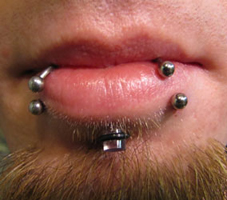
Tongue Stretching
The tongue can be stretched very well and painless. The best thing to do is engrave the tongue piercing at the beginning with a larger diameter and let it heal well. Usually you can start stretching after just 2 to 3 weeks and continue the stretching process at similar intervals.
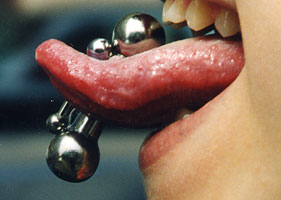
Intimate Stretching
As with all other places, caution is also required for intimate stretching. It must under no circumstances be stretched quickly or brutally, otherwise it can lead to serious tissue damage. One should make the smallest possible stretching steps and wait 4-6 weeks before starting to stretch further. Among the most frequently stretched intimal piercings include the labia, Christina, Fourchette and clitoris foreskin for woman and Prince Albert, Frenum, various scrotum and prepuce piercings for men. Stretching can increase the wearing comfort of the intimidate jewerlry in many cases, because a strong and heavy jewelry does not break down and is usually much better than a thin, the visual appeal of a larger piece of jewelry is often desirable.
Surface Piercing
A surface or surface piercing is a piercing that is not pierced in a skin fold. Many very popular piercings are actually surface piercings, this includes the very common eyebrow piercing. Surface piercings can be pierced almost anywhere, but some are more suitable than the others, and some should be avoided at all, since they tend almost always to grow out of the piercing or can be dangerous. Suitable body parts are those where the skin is not exposed to great stress. Strongly moving places are to be avoided in any case. When piercing a surface piercing, a long puncture channel is led horizontally under the skin and a specially curved surface connector is inserted. The final result is two spheres lying on the surface of the skin. Healing is often cumbersome and requires consistent and intensive care. The healing time depends on the length of the puncture channel, not infrequently, the complete healing takes 6 or even 12 months.
Dermal Anchor
So the special jewelry is called, which is used for implants. The jewel looks a bit like a Labret plug. It has on one side a flat plate, which is pushed under the skin. The other side visible from the outside is occupied by a ball, a disk or another ornamental attachment. For a Dermal Anchor, the skin is pierced with a dermal punch, then under the skin a little space for the anchor must be created and the jewelry is used. The procedure is not painful and relatively easy to perform. This type of jewelry can be used almost anywhere, but you should avoid places where the jewelry could exert pressure on the nerves. Places that are strongly movable and exposed to great stress, are also not recommended. In the lip, a dermal anchor is often a pleasant alternative to a regular Labret plug, as it can not hurt the teeth or the gums. The same is true for a cheek piercing: stung with a dermal anchor it is much less dangerous, heals faster and does not come into contact with the teeth and gums. Due to the relatively short healing time and the minimized risk of growing out, it is often advisable to use a dermal anchor instead of a surface piercing.
Piercing care
The duration of nursing depends on the pierced body part and on the body's defenses, so it is different for everyone. In the healing period you should not neglect the care, otherwise it can lead to various health complications (swelling, inflammation, infections). The appearance of the piercing may suffer. If such complications should show up, you have to have the piercing examined as quickly as possible by a qualified person.
- Wash and disinfect hands.
- Clean the outside with a disinfectant (eg Octenisept) so that no crust remains are visible.
- Rinse inside with a mucous membrane disinfectant solution.
- Chamomile or sage tea rinses are recommended.
- Bandages are not necessary, but you should disinfect several times a day.
- Duration of treatment: 2 weeks
- Do not eat acidic foods or dairy products during the first week.
- Rinse frequently with a mucous membrane disinfectant during the day.
- Chamomile or sage tea rinses are recommended.
- Duration of treatment: 1 week
- Wash and disinfect hands.
- Clean the wound several times a day with a disinfectant (eg Octenisept) so that no crust remains are visible.
- Duration of treatment: 1 - 2 weeks
- Wash and disinfect hands.
- Clean the wound several times a day with a disinfectant (eg Octenisept) so that no crust remains are visible.
- Duration of treatment: 2-3 weeks
- Wash and disinfect hands.
- Clean the wound with a disinfectant (eg Octenisept) so that no crust remains are visible.
- Provide the wound with a sterile bandage.
- Change the bandage twice a day.
- Treatment time is 2-3 weeks, but healing takes 3 to 12 months, depending on the length of the branch canal. During this time you should disinfect the piercing after each bathing or contamination.
- Wash and disinfect hands.
- Clean the piercing several times a day with a suitable skin or mucous membrane disinfectant.
- Duration of treatment: 1 week
Expenses
You should beware of too cheap piercings, because it is suspicious, if someone offers a 30 Euro piercing and raves about the hygiene.Here it is really worthy of caution, because it depends on your health! Considering that the effort when piercing not is small, if you really want to stab 100% sterile.There are the costs for sterilization, disposable material, disinfectants, proper disposal and good quality jewelry.The whole preparation takes much longer than the piercing itself, so do not be fooled the piercer has no cost and can easily get rid of it, almost for free. A cheap piercing can have dire consequences due to saving on consumables, including HIV or hepatitis infection, so be warned and do not save in the wrong place.
Regardless of the location, our prices are the same for all piercings (except intimate piercings), because you have a similar effort everywhere and use similar materials, no matter where they are stung. Prices may vary only due to different pieces of jewelry.
The price for piercing (also for Surface Piercings) is at us 50 euros + jewelry, which you can choose from our large assortment.
For a Intimate Piercing you pay with us 60 euros + jewelry of your choice, which is suitable for the pierced site.
A Dermal Anchor costs with us 60 euros including First use jewelry, if desired, you can add a glitter stone on surcharge.
Stretching costs 10 euros + jewelry.
When piercing several piercings or implants in one session, the price is much cheaper!
Piercing with self-brought jewelry is not possible for reasons of hygiene.
Piercing vouchers are available.
Piercing Course
The only requirements are the understanding of German language and interest. For further informations please write an E-Mail.


